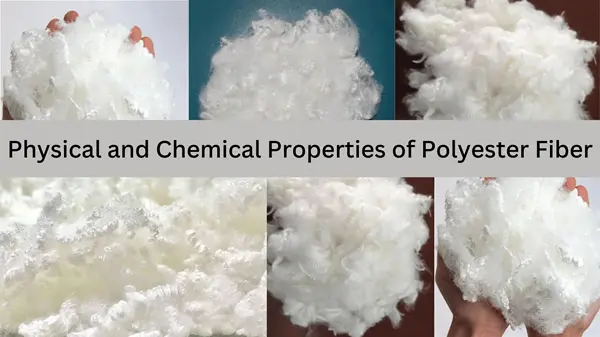Polyester is a synthetic fiber Man Made fiber, the technical name is PET (polyethylene terephthalate), generated by chemical process. The properties of the Polyester fiber are as follows. We measure it by categorizing it in two ways. One is Physical Property and another is chemical property. Here we are describing all the properties of polyester. In this article, we discuss the Physical and Chemical Properties of Polyester Fiber.

Physical and Chemical Properties of Polyester Fiber
Physical Properties of Polyester Fiber
- Shape and look: These are typically spherical and uniform. it is partly clear and white to slightly off-white in color.
- Strength: The polyesters are normally stronger. we use it for industrial purposes.
- Elasticity: Polyester fibers don’t have a high degree of snap. Normally polyester has a high degree of stretch resistance. It suggests that polyester materials aren’t seemingly to stretch out of form too simply.
- Resilience: Polyester has a high degree of resilience. It resists wrinkling while it is wet.
- Drapability: Materials of polyester filament have satisfactory draping quality. The small stuff of polyester is versatile and softer. Thereafter it has a good draping quality.
- Heat conduction: Polyester filaments are sensible conductors of warmth. It doesn’t offer larger insulation within the yarns and materials. The rationale for attire larger heat of polyester is low permeability.
- Absorbency: It has a low amount of absorbency which is one of the smallest amount of absorbent fibers. This low permeability has the necessary advantage that they’re going to dry in no time. Thy are well enough to water repellent functions, like rain wear and they don’t stain simply.
- Dimensional Stability: Polyester fiber has good dimensional stability. If the polyester is correctly heat set, it’ll not shrink, nor stretch once subjected to boiling water, boiling cleanup solvents, or ironing temperatures that are less than heat setting.
- Shrinkage: It has a good shrinkage property. It shrinks the maximum amount as twenty the longest enduring wet-finishing operations and that they heat set in later treatments. They need glorious dimensional stability.
- Cleanliness and Wash-ability: Since polyester fibers are typically swish, have low permeability, several stains lie on the surface, and simply washed out, by hand or machine however oil stains to get rid of.
Chemical Properties of Polyester Fiber
- Reaction to Alkalies: At temperature, polyesters have sensible resistance to weak alkalies and honest resistance to robust alkali. It reduces with an increase in temperature and alkaline concentration.
- Reaction to Acids: Polyester has sensible resistance to mineral and organic acids relying on kinds. Extreme solution degrades at high temperatures.
- Effects of Bleaches: We can bleach a polyester material safely. As we know polyesters have sensible resistance to deterioration of unit bleaches. If the polyester has an optical brightener, bleaching isn’t necessary.
- Effect of Heat: At temperature ironing is necessary. It gets sticky at 4400 F.
- Effect of sunshine: Polyester has sensible resistance to degradation of daylight. Over prolonged use, gradual deterioration of fiber happens.
- Affinity for Dyes: Polyesters are artificial with applicable disperse, developed dyes at high temperatures manufacturing an honest variety of shades and color fastness.
- Resistance to Perspiration: Polyesters do not lose strength in contact with either acid or alkali perspiration.
- Polyester Blends: Polyester cotton mix, polyester wool mix, polyester material, polyester silk mix, poly acetate mix, polyester, and nylon are some common blends.
Physical and Chemical Properties of Polyester Fiber
